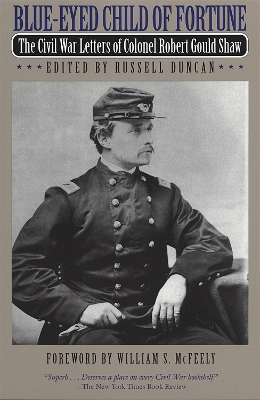On the Boston Common stands one of the great Civil War memorials, a magnificent bronze sculpture by Augustus Saint-Gaudens. It depicts the black soldiers of the 54th Massachusetts Infantry marching alongside their young white commander, Colonel Robert Gould Shaw. When the philosopher William James dedicated the memorial in May 1897, he stirred the assembled crowd with these words: "There they march, warm-blooded champions of a better day for man. There on horseback among them, in the very habit as he lived, sits the blue-eyed child of fortune". In this book Shaw speaks for himself with equal eloquence through nearly 200 letters he wrote to his family and friends during the Civil War. The portrait that emerges is of a man more divided and complex - though no less heroic - than the Shaw depicted in the celebrated film "Glory". The pampered son of wealthy Boston abolitionists, Shaw was no abolitionist himself, but he was among the first patriots to respond to Lincoln's call for troops after the attack on Fort Sumter. After Cedar Mountain and Antietnam, Shaw knew the carnage of war firsthand.
Describing nightfall on the Antietnam battlefield, he wrote, "The crickets chirped, and the frogs croaked, just as if nothing unusual had happened all day long, and presently the stars came out bright, and we lay down among the dead, and slept soundly until daylight. There were 20 dead bodies within a rod of me". When Federal war aims shifted from an emphasis on restoring the Union to the higher goal of emancipation for four million slaves, Shaw's mother pressured her son into accepting the command of the North's vanguard black regiment, the 54th Massachusetts. A paternalist who never fully reconciled his own prejudices about black inferiority, Shaw assumed the command with great reluctance. Yet, as he trained his recruits in Readville, Massachusetts, during the early months of 1863, he came to respect their pluck and dedication. "There is not the least doubt", he wrote to his mother, "that we shall leave the state, with as good a regiment as any that has marched". Despite such expressions of confidence, Shaw in fact continued to worry about how well his troops would perform under fire.
The ultimate test came in South Carolina in July 1863, when the 54th led a brave but ill-fated charge on Fort Wagner, at the approach to Charleston Harbour. As Shaw waved his sword and urged his men forward, an enemy bullet felled him on the fort's parapet. A few hours later the Confederates dumped his body into a mass grave with the bodies of 20 of his men. Although the assault was a failure from a military standpoint, it proved the proposition to which Shaw had reluctantly dedicated himself when he took command of the 54th: that black soldiers could indeed be fighting men. By the year's end, 60 new black regiments were being organised.
- ISBN13 9780820342771
- Publish Date 15 August 2011 (first published 1 October 1992)
- Publish Status Active
- Publish Country US
- Imprint University of Georgia Press
- Format eBook
- Pages 480
- Language English
